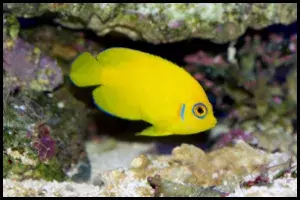

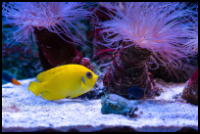
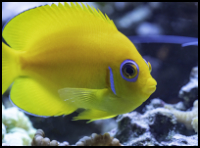
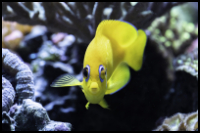
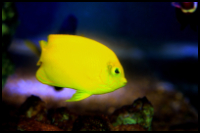
Quick Care Details (Table)
| Livestock Characteristics | Value |
|---|---|
| Care Level | Moderate |
| Temperament | Semi-Aggressive |
| Diet | Omnivore |
| Maximum Size | 5.5 Inches |
| Minimum Tank Size | 55 Gallons |
| Reef Compatible | With Caution |
| Temperature Range | 72-78F |
| PH Range | 8.1-8.4 |
| Salinity Range | 1.020-1.025 |
| Alkanlinity | 8-12 dKH |
Species Specific Categories
Helpful Video
Care Details
Aquascape
- These fish prefer aquariums with plenty of live rock and hiding spots, mimicking their natural reef habitat.
- Incorporate caves, crevices, and overhangs to provide hiding places for the fish.
- Include some open swimming space to accommodate their active nature.
Substrate
- A sand substrate is ideal for the these Angelfish as it allows them to sift through the sand looking for food.
- Fine to medium-grade sand is recommended to prevent the fish from accidentally ingesting large particles.
Disease Prevention
- Quarantine any new fish before adding them to the main tank to prevent introducing diseases.
- Maintain excellent water quality through regular water changes and monitoring of parameters like ammonia, nitrite, and nitrate.
- Avoid overfeeding to prevent food decay and water pollution.
- Observe the fish daily for any signs of illness, and if any issues arise, take appropriate action promptly.
Filtration
- A quality filtration system is crucial to keep the water clean and clear.
- Consider a combination of mechanical, biological, and chemical filtration for optimal results.
- Regularly clean or replace filter media to prevent the accumulation of detritus.
Lighting
- This fish does not have any specific lighting requirements.
- Aim for a lighting setup that supports the health of any live plants in the aquarium and enhances the colors of the fish.
Water Flow
- Provide moderate water flow in the aquarium to mimic their natural reef environment.
- Avoid strong, direct currents as they may stress the fish or make swimming difficult.
Hardiness
- These angelfish are generally hardy when kept in a stable and well-maintained aquarium environment.
- Ensure proper acclimation when introducing them to the tank to reduce stress.
- Provide a balanced diet and a suitable habitat to support their overall health and well-being.
Temperament and Behavior
Behavior and Social Interaction
- These fish are generally peaceful but can become territorial, especially as they mature.
- They may exhibit aggression towards other angelfish or similarly shaped species.
- It is best to keep Lemonpeel Angelfish in a species-specific aquarium or with peaceful tank mates.
Aggression
- While they are not aggressive in the traditional sense, they may defend their territory or become territorial towards other fish.
- Their aggression is usually more pronounced when kept with other angelfish or similar-looking species.
Breeding
- Breeding Lemonpeel Angelfish in captivity is challenging and not commonly achieved.
- In the wild, they engage in courtship rituals where the male and female swim together and display specific behaviors.
Compatibility
- Lemonpeel Angelfish are generally compatible with peaceful fish species that don't resemble angelfish.
- Avoid keeping them with other angelfish, as this can lead to territorial conflicts.
- In a reef aquarium, exercise caution when keeping them with small, delicate invertebrates, as they may pick at some corals or ornamental shrimp.
Activity Level
- These angelfish are active swimmers and constantly explore their environment.
- They enjoy perching on live rock and will often patrol their territory throughout the day.
Clean-up Crew
- Lemonpeel Angelfish are not considered part of the "clean-up crew" in a marine aquarium.
- They do not consume algae to the extent that some other fish, like certain tang species, do.
Schooling or Shoaling Behavior
- This angelfish species are not schooling or shoaling fish.
- They are typically encountered as solitary individuals or in mated pairs on the reef.
Diet and Nutrition
Dry Foods
- High-quality marine pellets and flakes are suitable for this angelfish.
- Look for products that contain a variety of ingredients, including spirulina and other algae-based components.
Frozen Foods
- Offer frozen foods such as mysis shrimp, brine shrimp, and krill.
- Frozen foods should be thawed and rinsed before feeding to remove any excess salt and ensure cleanliness.
Live Foods
- Angelfish are omnivores and will accept live foods like brine shrimp, copepods, and small worms.
- Culturing live foods at home can be a great way to provide them with nutritious live prey.
Vegetables
- Some Angelfish may nibble on blanched vegetables like spinach, zucchini, or seaweed.
- However, not all individuals will readily consume vegetables, so it's essential to provide a balanced diet with other food types.
Algae
- These Angelfish are omnivorous and will graze on algae in their natural habitat.
- In the aquarium, providing them with marine algae sheets or dried seaweed on a clip can be beneficial.
Feeding Schedule
- Offer small, frequent feedings throughout the day, mimicking their natural grazing behavior.
- A good rule of thumb is to feed them 2-3 times a day in smaller portions rather than a single large feeding.
Supplemental Foods
- To enhance their diet, consider adding vitamin or mineral supplements occasionally.
- Ensure the supplements are specifically formulated for marine fish and follow the manufacturer's recommendations for dosage.
Tank Parameters
Tank Size
- This Angelfish require a tank size of at least 30 gallons (113 liters).
- Larger tanks, preferably 55 gallons (208 liters) or more, provide more swimming space and stability for the fish.
Tank Length and Measurements
- The exact tank measurements will depend on the tank's shape and design.
- As a general guideline, aim for a tank length of at least 30 inches (76 centimeters) to allow the fish enough room to swim and explore.
The Species Maximum Size
- Lemonpeel Angelfish can grow up to 4-5 inches (10-13 centimeters) in length.
- Providing adequate space in the aquarium is essential to accommodate their potential size.
Water Temperature
- The ideal water temperature range for the Lemonpeel is between 72°F and 78°F (22°C - 26°C).
- Maintaining a stable and suitable temperature is crucial for their overall health and well-being.
pH (Acidity/Basicity)
- The recommended pH range for this fish species is around 8.1 to 8.4.
- Stability in pH is essential, as sudden fluctuations can stress the fish.
Nitrate (NO3) Levels
- It is crucial to keep nitrate levels low in the aquarium to ensure the health of the fish and other tank inhabitants.
- Ideally, nitrate levels should be kept below 20 ppm, and frequent water changes can help achieve this.
Salinity
- Salinity refers to the concentration of dissolved salts in the water.
- For a saltwater fish aquarium, the recommended salinity is typically between 1.020 to 1.025 specific gravity (approximately 30 to 35 parts per thousand, ppt).
- Maintaining stable salinity levels is crucial for the health of marine fish, including this angelfish.
- Use a reliable hydrometer or refractometer to measure and monitor salinity regularly.
Phosphate (PO4)
- Phosphate is a nutrient present in aquarium water, mainly from fish waste, uneaten food, and decaying organic matter.
- Elevated phosphate levels can lead to algae growth and negatively impact water quality.
- Aim to keep phosphate levels below 0.03 ppm (parts per million) in a saltwater fish aquarium.
- Regular water changes, proper filtration, and careful feeding practices can help control phosphate levels.
Alkalinity (dKH)
- Alkalinity, also known as carbonate hardness, is a measure of the water's buffering capacity against pH changes.
- In a reef aquarium, alkalinity should be maintained between 8 to 12 dKH (degrees of carbonate hardness or approximately 140 to 214 ppm).
- Stable alkalinity is essential for coral health and pH stability.
History, Popularity, History and Species Variety Details
The History, Popularity and Habitat
History:
The Lemonpeel Angelfish (Centropyge flavissima) has captured the fascination of aquarists and divers alike since its discovery. It was first scientifically described by Cuvier in 1831. Over the years, advancements in marine aquarium technology and international trade have made this species more accessible to hobbyists around the world.
As with many marine fish, the exact history of the Lemonpeel Angelfish's popularity in the aquarium trade is difficult to trace. However, it gained widespread attention due to its stunning appearance, characterized by its brilliant lemon-yellow body and contrasting electric blue markings. The vibrant colors and relatively small size have made it a sought-after addition to both beginner and experienced marine aquariums.
Popularity:
The Lemonpeel Angelfish has achieved considerable popularity among marine aquarium enthusiasts due to its striking appearance and active behavior. Its bright yellow coloration adds a vibrant splash to any saltwater tank, making it an eye-catching centerpiece. Additionally, its compatibility with reef environments, provided they are well-established and have ample hiding spots, further adds to its appeal.
As its popularity grew, captive breeding efforts were initiated to reduce the dependence on wild-caught specimens. Successful breeding in captivity, although challenging, has led to more sustainable availability in the aquarium trade. The increased availability of captive-bred Lemonpeel Angelfish has helped alleviate some pressures on wild populations, promoting responsible aquarium keeping.
Habitat:
The Lemonpeel Angelfish is native to the warm tropical waters of the Indo-Pacific region. Its range extends from the eastern coast of Africa, including the Red Sea, to the central Pacific Ocean, encompassing regions such as Hawaii and the Marquesas Islands. Within this vast area, they are found in various reef habitats, including coral reefs, rocky outcrops, and lagoons.
In the wild, Lemonpeel Angelfish prefer areas with abundant hiding spots, such as crevices and overhangs, where they can seek shelter and feel secure. They are often observed swimming near the reef structure, where they graze on algae and small invertebrates. The presence of live rock and coral in the aquarium helps replicate their natural habitat and provides opportunities for them to explore and forage.
Being naturally territorial, Lemonpeel Angelfish stake out their territory on the reef. In the aquarium setting, they may exhibit similar territorial behavior, especially if kept with other angelfish or fish with similar body shapes. Proper tank size, habitat structure, and compatible tankmates are essential to create a harmonious environment for this beautiful species.
Back to topFish Species Variations
- Morphological Variations: While the Lemonpeel Angelfish generally displays a bright lemon-yellow body with electric blue markings, there can be slight variations in color intensity and pattern. Some individuals may have more vibrant yellow hues, while others might have more prominent blue markings.
- Regional Color Differences: Lemonpeel Angelfish found in different regions of their native range may exhibit subtle variations in coloration. For example, those from Hawaii may have slightly different color patterns compared to specimens from the Red Sea.
- Hybridization and Interspecies Variations: In some cases, hybridization between different angelfish species may occur, resulting in unique color combinations and patterns. These hybrids can exhibit characteristics of both parent species.
- Captive-Bred Variations: With advancements in captive breeding techniques, some breeders have reported variations in Lemonpeel Angelfish coloration from captive-bred individuals compared to their wild counterparts. These variations can arise due to genetic diversity and selective breeding practices.
- Environmental Factors: The diet and environment in which Lemonpeel Angelfish are kept can influence their coloration and overall appearance. For example, a diet rich in carotenoid pigments can intensify their yellow coloration.
Common Tankmates
- Other Peaceful Community Fish: Choose peaceful community fish that are not aggressive and can handle the occasional territorial behavior of the Lemonpeel Angelfish. Examples include:
- Clownfish (Amphiprion species)
- Gobies (e.g., Watchman Gobies, Yellow Clown Gobies)
- Chromis (Chromis species)
- Cardinalfish (e.g., Banggai Cardinalfish)
- Firefish (Nemateleotris species)
- Damsels and Anthias: Some species of damsels and anthias can be compatible with the Lemonpeel Angelfish, as long as they are not overly aggressive. Avoid aggressive or territorial damsels.
- Peaceful Wrasse: Certain species of peaceful wrasses can coexist with the Lemonpeel Angelfish, provided there is enough space in the tank. Look for non-aggressive wrasses such as Flasher Wrasses (Paracheilinus species).
- Small Tangs and Surgeonfish: Some small species of tangs and surgeonfish can work well in larger aquariums. Choose those known for their peaceful nature, such as the Yellow Tang (Zebrasoma flavescens) or the Tomini Tang (Ctenochaetus tominiensis).
- Invertebrates: Many invertebrates are generally compatible with the Lemonpeel Angelfish. Consider adding peaceful species like:
- Cleaner Shrimp (Lysmata species)
- Snails and Hermit Crabs (e.g., Nassarius, Trochus, Scarlet Hermit)
- Peppermint Shrimp (Lysmata wurdemanni)
- Small to Medium-sized Blennies and Gobies: Look for blennies and gobies that are not aggressive and won't compete with the Lemonpeel Angelfish. Examples include the Tailspot Blenny (Ecsenius stigmatura) or the Watchman Goby (Cryptocentrus species).
Male gender vs Female gender (Sexual Dimorphism)
1. Observe Behavior: Males may exhibit more territorial and aggressive behavior compared to females, especially during the breeding season. They might establish and defend territories on the reef or within the aquarium.
2. Fin Shape and Size: Males might have slightly longer and more pointed dorsal and anal fins compared to females. However, these differences can be subtle and challenging to discern, especially in younger fish.
3. Color Intensity: In some cases, males might display more vibrant and intense colors compared to females, particularly during courtship and spawning periods. However, this can vary among individuals and is not always a reliable indicator.
4. Egg Spots: In mature males, there might be small white spots, known as "egg spots," on the anal fin. These spots are not actual eggs but mimic them and are thought to play a role in courtship and mating behavior.
5. Size and Body Shape: In some angelfish species, males are slightly larger than females, but this difference is usually not significant in Lemonpeel Angelfish. Additionally, body shape differences are generally not apparent enough to reliably identify gender.
6. Breeding Behavior: In a mating pair, males may display courtship behaviors towards females, including swimming together, chasing, and other courtship rituals.
The Lemonpeel Angelfish is one of the first captive bred fish for this species since announced in 2002. It is extremely difficult to breed these in captivity and should only be attempted by experts in the aquarium hobby. If you would like to attempt here are some steps to try.
1. Acquire a Mated Pair: First, you'll need to obtain a mated pair of Lemonpeel Angelfish. This can be achieved by purchasing a bonded pair from a reputable breeder or retailer. It's essential to ensure that the pair is compatible and exhibits courtship behaviors.
2. Provide a Suitable Habitat: Create a well-established and stable marine aquarium with plenty of live rock, hiding spots, and crevices. The tank should be at least 55 gallons (208 liters) in size to provide enough space for the pair and potential offspring.
3. Feed a Nutritious Diet: A healthy diet is crucial for successful breeding. Feed the angelfish a varied and balanced diet that includes high-quality marine pellets, frozen foods, and live foods. Adding foods rich in carotenoids, such as spirulina and certain types of algae, can enhance coloration and overall health.
4. Observe Courtship Behavior: Mating pairs of Lemonpeel Angelfish will display courtship behaviors, including swimming together, chasing, and possible fin displays. Observe their behavior closely to ensure they are bonded and ready for spawning.
5. Provide a Spawning Site: Lemonpeel Angelfish are egg-layers that release their eggs in a specific location. Provide a flat, clean surface, such as a piece of slate or a large coral rock, as a potential spawning site.
6. Monitor Spawning: When the pair is ready to spawn, they will lay their eggs on the chosen surface. Watch for the eggs, which are small and spherical, and avoid disturbing the nesting site to prevent stress.
7. Separate the Eggs: Once the eggs have been laid, it's essential to remove them from the main tank to prevent other tank inhabitants from consuming them. Carefully transfer the eggs to a separate, appropriately sized egg-rearing tank.
8. Egg Rearing Tank Setup: Set up the egg-rearing tank with appropriate water conditions, similar to the main tank. Provide gentle water flow and aeration to ensure adequate oxygenation for the developing eggs.
9. Incubation and Hatching: The eggs will undergo an incubation period before hatching into larvae. The time it takes for the eggs to hatch can vary depending on temperature and other environmental factors.
10. Raising Fry: Once the eggs hatch, the larvae will become free-swimming. At this stage, they require tiny live foods, such as rotifers and copepods, for nourishment. As the fry grow, you'll need to transition them to larger live and frozen foods.
Back to topDisease and Quarantine
Copper Treatment:
- Purpose: Copper treatment is used to treat external parasites, such as ich (Ichthyophthirius multifiliis) and marine velvet (Amyloodinium ocellatum).
- Tolerance: Copper treatments can be stressful for marine fish, including this species. Careful monitoring and precise dosing are essential to avoid toxicity.
Hyposalinity:
- Purpose: Hyposalinity is used to treat external parasites, primarily saltwater ich.
- Tolerance: This species can tolerate short-term hyposalinity treatments when carefully executed and monitored. Avoid prolonged exposure to low salinity.
Tank Transfer:
- Purpose: Tank transfer, or "fish-only transfer method," is used to remove external parasites from fish by moving them between tanks with different salinities.
- Tolerance: This species can tolerate tank transfers when done correctly and gradually to avoid stress.
Hybrid Tank Transfer:
- Purpose: Similar to regular tank transfer, but it involves using both freshwater and saltwater to induce stress in parasites, making them detach from the fish.
- Tolerance: This species can tolerate this method if conducted with care and proper acclimation.
Hydrogen Peroxide Bath:
- Purpose: A hydrogen peroxide bath is used to treat external parasites and certain infections on the fish's body.
- Tolerance: This species may not tolerate hydrogen peroxide baths well, as it can be harsh on their delicate skin and gills.
Freshwater Dip:
- Purpose: A brief immersion in freshwater to dislodge external parasites.
- Tolerance: This species can tolerate a short freshwater dip if done carefully and for a short duration.
Methylene Blue:
- Purpose: Methylene blue is used to prevent and treat fungal and bacterial infections.
- Tolerance: This species can tolerate methylene blue when used in appropriate concentrations and for a limited time.
Praziquantel:
- Purpose: Praziquantel is used to treat internal parasites, including flukes.
- Tolerance: This species can tolerate praziquantel when administered according to the recommended dosage.
Metronidazole:
- Purpose: Metronidazole is used to treat internal parasites and certain protozoan infections.
- Tolerance: This species can tolerate metronidazole when used correctly.
Formalin:
- Purpose: Formalin is used to treat external parasites and certain infections.
- Tolerance: This species may not tolerate formalin well, and its use requires careful monitoring and proper dosing.
Fenbendazole:
- Purpose: Fenbendazole is used to treat internal worms in fish.
- Tolerance: This species can tolerate fenbendazole when used as directed.
Chloroquine Phosphate:
- Purpose: Chloroquine phosphate is used to treat marine ich and some other parasitic infections.
- Tolerance: This species can tolerate chloroquine phosphate when used according to the recommended dosage.
Antibiotics:
- Purpose: Antibiotics are used to treat bacterial infections.
- Tolerance: This species can tolerate certain antibiotics when used correctly, but care must be taken to avoid potential harm to beneficial bacteria in the aquarium.
Acriflavine:
- Purpose: Acriflavine is used to treat various external infections and wounds.
- Tolerance: This species can tolerate acriflavine when used as directed, but it may stain the water and can be toxic at higher concentrations.
Frequently Asked Questions
What is the average size of a fully grown Lemonpeel Angelfish?
Lemonpeel Angelfish can grow up to 4-5 inches (10-13 centimeters) in length.
Are Lemonpeel fish suitable for reef aquariums?
Sometimes, Lemonpeel Angelfish are generally considered reef-safe if you only keep SPS, but caution is advised with some soft corals and ornamental shrimp, as they may nip at them.
Can Lemon Angelfish be kept in pairs?
It is generally not recommended to keep multiple Lemonpeel Angelfish together, as they can become territorial and aggressive towards one another.
What type of diet do Lemonpeel Angelfish require?
Lemonpeel Angelfish are omnivores and should be fed a varied diet consisting of high-quality marine pellets, frozen foods, live foods, and algae.
Are Lemonpeel Angelfish challenging to care for?
Lemonpeel Angelfish have specific care requirements, and their aggressive tendencies can make them more challenging for beginner aquarists. Experienced hobbyists are better suited for their care.
Can Lemonpeel Angelfish be kept with other fish?
Yes, they can coexist with peaceful community fish, but avoid keeping them with other angelfish or similarly shaped species. Also consider they should not be kept with extremely small fish as the might see them as a snack.
Can Lemonpeel Angelfish change their color over time?
Lemonpeel Angelfish may exhibit color variations based on factors like diet and environment, but their core lemon-yellow body color with blue markings remains consistent.
Can Lemonpeel Angelfish be bred in captivity?
Yes, it is possible to breed Lemonpeel Angelfish in captivity, but it requires specialized knowledge and equipment. Breeding is challenging and not commonly achieved.

